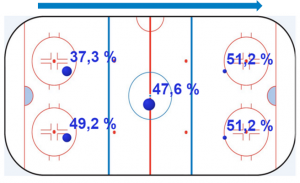If you don’t believe Analytics and Sports go together you may want to stop reading here. Or you may want to start with validating my previous reasoning on "Why Sports should embrace analytics". If you find you are past the “Why?” you may instead think that the title above doesn’t call for a page long article, that Nike’s slogan “Just do it” would be sufficient as a recommendation.
I can see that point of view, I used to think that surfacing information that was previously unknown would be enough to trigger engagement, buy-in and action. However, more than once I’ve found that exposing a sports management team to information they never saw before based on data they didn’t realize existed leads to nothing following the meeting.
Even though they clearly both see and express how these things would be valuable to them it doesn’t necessarily move forward from there. So, assuming that the question “Why?” is not an issue, let’s take a look at “How?”, how do you engage with analytics in order to make it operational and contribute to the team?
Be relevant
Realizing this may at first sight qualify as a true “no-brainer”, it still can’t be pointed out often enough. Relevance is everything and it applies to information, communication as well as timing.
Let’s start with information relevance, what information are you presenting? In sports especially, there are so many things that you can do with statistics and analytics that are interesting, and maybe even entertaining, and they can lead to amusing discussions, but if you want people to truly engage it is essential that the information is relevant, something that clearly aligns with an agreed objective. For the sake of illustration, let’s use hockey face-offs as a very basic example.
Possessing the puck is important, therefore face-offs are important, hence measuring and knowing different players’ face-off percentages are valuable. 50% is good, higher is of course better, 60% is excellent, above that is rare and exceptional. But players’ faceoff percentages are not consistent around the rink, they typically vary considerably between different circles on the ice. So the detailed information below adds relevance since it more clearly indicates who to have or not have on the ice pending the situation.

Crucial face-off in your defensive left circle, you may want somebody else in there, right? As the British Rowing team phrased it, if it provides an answer to the question “Will it make the boat go faster?” the information is relevant.
Source: Twitter account @JonBlomqvist
Let’s move to Communication relevance. How to visualize your findings. The human brain remembers pictures. Look again at the image above, it takes a few seconds only for everyone in the room to grasp the context and it’s easy to recall from memory. And as you talk about the findings and the implication, make sure you use a language that is understood and keeps the listener on track, words like “odds” and “probability” will probably work while “standard deviation” and “r square value” will likely not.
Timing relevance relates to understanding when the information adds value. In connection with practice or with game? When evaluating, preparing or executing? Understand the process and add value to it by timing the information. If it’s not relevant to the situation it will become noise, no matter how correct and valuable it may seem to you. And insights not put into practice remain only insights, nothing more.
As you move forward from known areas and statistics to new and more advanced analysis, as long as you stick to relevance in information, communication and timing you can’t go wrong.
Form a team
Engaging in Analytics is not something for one person to do in isolation. To be successful the whole staff needs to embrace analytics, from GM to assistant coaches, they have to be involved, one way or another. Even if one person has all the skills required, which is rare, you above all need collaboration and communication, validation of findings and different perspectives in order to achieve a joint trust of results and execution thereupon
A sports team that follows these guidelines on “How” will gain insights that will lead to actions that will make a difference.
And by the way, if you’re not involved in sports but work in business or public service, this same answer to “How?” when embracing Analytics applies in order to gain success. Be relevant with regards to Information, Communication and Timing and Form a Team.
At the Data Innovation Summit event I laid out some of these thoughts in my main stage presentation and in a wider context for a few minutes in this video. Your feedback and thoughts are highly appreciated.
Read also Christer's other posts about sports analytics:
Why Sports is the ultimate arena for Analytics
Analytics is a team sport at Team Sweden
What demand planners can learn from Sports Analytics
Why sports should embrace analytics
